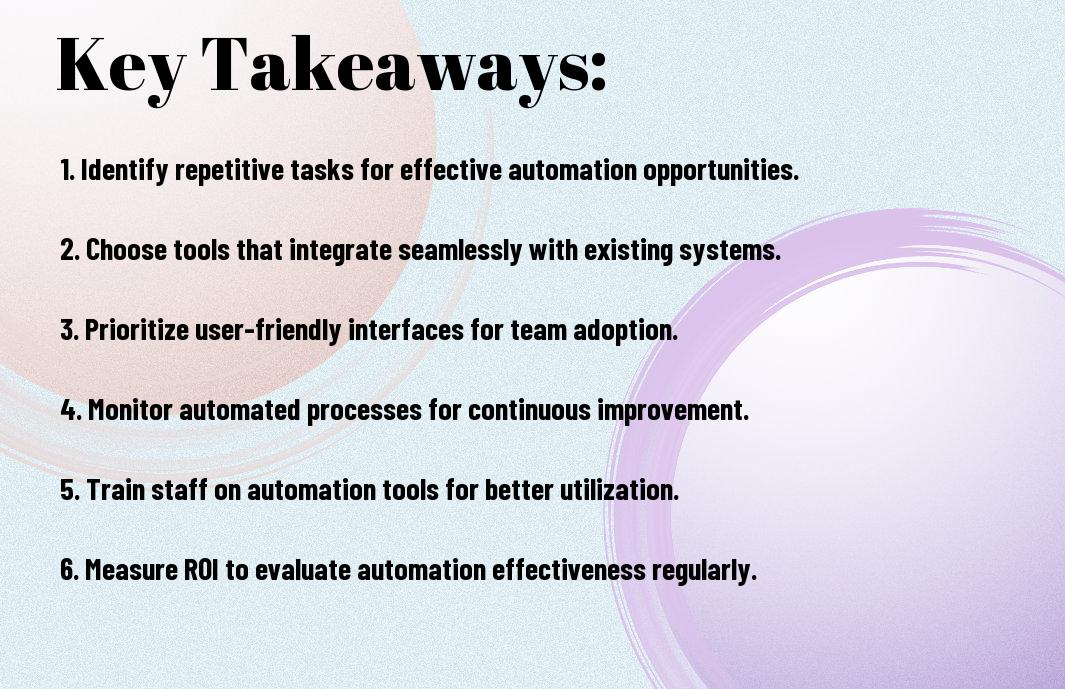There’s a growing emphasis on automation as a key driver for operational efficiency in your business. By streamlining your processes, you can maximize productivity and enhance your competitive edge. In this post, you will discover nine expert tips that can transform how you approach automation. Whether you are just starting out or looking to refine your strategies, these insights will guide you on your path. For additional resources, check out the 10 Best Practices to Automate Business Processes to further enhance your understanding.
Key Takeaways:
- Identify repetitive tasks that can benefit from automation to increase efficiency and reduce labor costs.
- Invest in user-friendly automation tools that integrate well with existing systems to ensure seamless adoption by your team.
- Regularly analyze performance metrics to measure the impact of automation on productivity and make necessary adjustments.
- Foster a culture of continuous improvement by encouraging feedback and innovation from employees regarding automation processes.
- Stay informed about emerging trends and technologies in automation to keep your business competitive in the evolving marketplace.

Understanding Automation
Your business’s success heavily relies on understanding automation, a powerful tool that streamlines processes and enhances productivity. By incorporating automation, you can reduce manual tasks, allowing you to focus on strategic growth and innovation. To maximize effectiveness, it’s vital to grasp how automation can be integrated into various aspects of your operations.
Definition of Automation
Around the globe, automation refers to the use of technology and systems to perform tasks with minimal human intervention. This can range from simple software functions that automate repetitive jobs to sophisticated AI that optimizes decision-making and enhances operational efficiency. By leveraging automation, you are investing in the intelligence and efficiency of your business processes.
Importance of Automation in Business
Behind every successful business today lies a robust system of automation that fosters agility and efficiency. As you navigate a competitive landscape, integrating automated solutions allows for real-time data tracking and faster decision-making, enabling you to respond promptly to market demands and customer needs.
Considering the rapid pace of technological advancement, automation serves as a game changer for businesses of all sizes. By adopting automated systems, you can minimize errors, cut down on operational costs, and improve overall customer satisfaction. In essence, automation not only saves your time but also empowers you to allocate resources better, allowing your business to innovate and grow in an increasingly digital world.
Identifying Automation Opportunities
Some businesses often overlook the potential for automation in their everyday operations. By carefully analyzing specific tasks, processes, and workflows, you can identify areas ripe for automation. The key is to focus on repetitive tasks that consume valuable time and resources. Once you recognize these opportunities, you can take proactive steps towards implementing automated solutions that boost productivity and efficiency.
Assessing Business Processes
For effective automation, start by mapping out your business processes to pinpoint where automation can have the most impact. Break down each task and evaluate its complexity, duration, and frequency. Identifying bottlenecks and redundancies will enable you to streamline operations and prioritize which processes to automate first.
Common Areas for Automation
Behind many successful businesses lie common areas where automation can unlock significant benefits. From customer relationship management and email marketing to inventory management and payroll processing, these functions can often be automated to save time and reduce error rates. Embracing automation in these areas helps you focus on strategic tasks that drive growth.
The adoption of automation in common areas such as customer support, data entry, and scheduling can lead to enhanced efficiency and improved accuracy. By leveraging tools like chatbots for customer inquiries or software for automating reports, you free up your team’s time to concentrate on core business activities. This shift not only optimizes operational performance but also ensures a seamless experience for your customers, ultimately contributing to your business success.

Choosing the Right Tools
Many factors contribute to selecting the right automation tools for your business. You’ll want to consider your specific needs, budget, and the scalability of the software. Take the time to research and compare different options to find tools that not only align with your current practices but also have the potential to grow with you. The right tools can significantly enhance your efficiency and contribute to your long-term success.
Evaluating Automation Software
For effective evaluation, start by identifying your business processes that require automation. List the features you need, and search for software that meets those requirements. Don’t forget to read reviews and seek recommendations from other users to gain insights into software performance and support. A thorough evaluation will help you make informed decisions that lead to increased productivity.
Integration with Existing Systems
With effective automation solutions, seamless integration with your existing systems is vital for maximizing efficiency. Look for tools that can easily connect to your current software, whether it’s a CRM, accounting platform, or project management tool. This ensures that your data flows smoothly across platforms and reduces the need for manual entry, ultimately saving you time and reducing errors.
It’s important to analyze how well potential automation tools will mesh with your existing systems. Evaluate whether they offer APIs or compatible plugins that facilitate easy integration. The smoother the integration process, the quicker you can see the benefits of automation. Make sure to account for any potential disruptions during the transition and plan accordingly to ensure a seamless switch that enhances your operational capabilities.
Implementing Automation Strategies
For successful automation, you need to develop a strong strategy that aligns with your business goals. Begin by identifying the processes that can benefit from automation and then prioritize them based on the potential impact on efficiency and productivity. By taking a structured approach, you can effectively streamline your operations while ensuring a smooth transition into automation.
Step-by-Step Implementation Process
Any successful implementation process consists of strategic steps that guide your path forward:
| Step | Description |
| 1. Identify Processes | Assess tasks suitable for automation. |
| 2. Set Goals | Define clear outcomes for automation. |
| 3. Choose Tools | Select the right automation tools for your needs. |
| 4. Test | Run pilot tests to identify issues. |
| 5. Implement | Launch the automation solution across the selected processes. |
Training Your Team
To ensure your team is equipped for the transition, adequate training is vital. Providing comprehensive training on new automation tools will empower your employees to leverage technology effectively and confidently.
Even with the best tools in place, your team’s success hinges on their understanding and ability to use these tools properly. Invest time in crafting tailored training sessions that cater to different skill levels, offering hands-on experience and ongoing support. This not only enhances proficiency but also fosters a culture of adaptability and innovation within your organization.
Monitoring and Evaluation
All successful automation strategies rely on continuous monitoring and evaluation to gauge effectiveness. By regularly assessing performance, you can identify areas for improvement and ensure that your automated processes align with your business goals. Check out 30 Actionable Tips for Business Process Automation to enhance your monitoring techniques and drive your business forward.
Key Performance Indicators (KPIs)
Among the key elements to track are Key Performance Indicators (KPIs), which serve as benchmarks for your automated processes. Defining and measuring KPIs allows you to evaluate effectiveness, uncover inefficiencies, and make informed decisions to optimize your automation initiatives.
Adjusting Automation Strategies
Above all, adjusting your automation strategies based on monitoring outcomes is imperative for long-term success. As your business environment and objectives evolve, your automation practices should adapt accordingly to remain effective.
Considering the dynamic nature of business, it’s important to regularly revisit your automation strategies. Assess your results against your KPIs, and don’t hesitate to refine your processes as needed. This proactive approach ensures that your automation solutions evolve alongside your business, maximizing efficiency and effectiveness while helping you stay ahead of the competition.

Overcoming Challenges in Automation
Once again, integrating automation into your business processes comes with its own set of challenges. You might face technical difficulties, resistance from team members, or concerns over data security. However, by acknowledging these issues and employing strategic solutions, you can create a smoother transition into an automated environment that ultimately enhances your productivity and operational efficiency.
Addressing Resistance to Change
Above all, it’s common to encounter resistance from employees when introducing new automated systems. To tackle this, openly communicate the benefits of automation and involve your team in the planning process. By fostering a culture of collaboration and support, you can ease fears and empower your team to embrace innovation.
Ensuring Data Security
Addressing data security is vital when implementing automation in your business. You need to have clear policies and technologies in place to protect sensitive information from potential breaches. Ensuring compliance with regulations and employing robust security measures should be a top priority to safeguard your business and maintain customer trust.
In fact, securing your data involves a multi-faceted approach that includes regular system audits, employee training, and employing encryption technologies. By regularly assessing vulnerabilities and updating your security protocols, you will strengthen your defense against potential threats. Additionally, informing your staff about best practices for data handling can create a culture of vigilance, further protecting your business from risks associated with automation.
To wrap up
Taking this into account, implementing automation strategies can significantly enhance your business operations and drive success. By following these 9 expert tips, you can streamline processes, reduce human error, and free up your valuable time for strategic initiatives. Embrace the technology that aligns with your goals, and consistently evaluate and adapt your automation efforts to ensure optimal results. You have the tools to transform your business and achieve greater efficiency and productivity.
FAQ
Q: What are the initial steps to implement automation in my business?
A: Start by assessing your current business processes to identify repetitive and time-consuming tasks. Consider areas where automation can save time and reduce errors, such as invoicing, customer relationship management, and email marketing. Once you have identified these areas, research automation tools that can fit your needs and budget, and then create a plan outlining the implementation process.
Q: How can I ensure that my team is ready for automation?
A: Preparing your team for automation involves effective communication and training. Organize workshops to explain the benefits of automation, address concerns, and clarify how it will impact their roles. Providing training sessions on the new tools will enhance confidence and encourage a smooth transition, ensuring your team feels supported throughout the process.
Q: What types of tasks are best suited for automation?
A: Tasks that are repetitive, rule-based, and structured are generally ideal for automation. Examples include data entry, payroll processing, email marketing campaigns, social media posting, and customer support through chatbots. Identify processes that take considerable time and could benefit from increased efficiency through automation.
Q: Are there any risks associated with automating business processes?
A: Yes, while automation can enhance efficiency, it can also introduce risks such as technical failures, data security concerns, and dependency on technology. It is vital to have a contingency plan in place, regularly update software, and ensure data protection measures are applied. Additionally, keeping a human element in customer interactions can maintain customer satisfaction.
Q: How can I measure the success of automation in my business?
A: Success can be measured through various key performance indicators (KPIs). Track metrics such as time saved, costs reduced, productivity levels, and error rates before and after implementing automation. Customer satisfaction surveys and employee feedback can also provide insights into the effectiveness of automation in your operations.
Q: What role does integration play in automating business processes?
A: Integration is vital for the success of automation as it allows different systems to communicate and share data seamlessly. Using integration tools helps to eliminate data silos, ensuring that information flows smoothly between applications, enhancing overall workflow efficiency. Look for automation tools that offer robust integration capabilities with your existing software.
Q: Can small businesses benefit from automation, and if so, how?
A: Absolutely! Small businesses can significantly benefit from automation by streamlining operations, reducing overhead costs, and freeing up time for strategic activities. Automation can help small businesses handle tasks such as customer communications and accounting more efficiently, allowing them to focus on growth and better service delivery.

